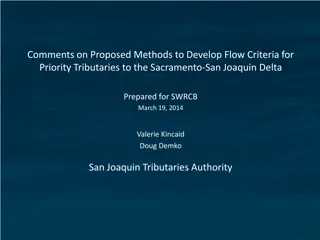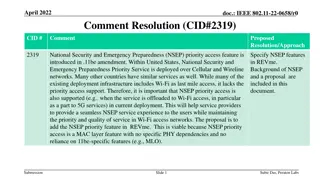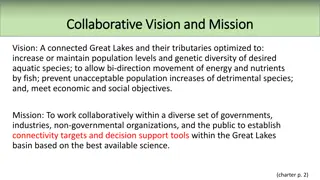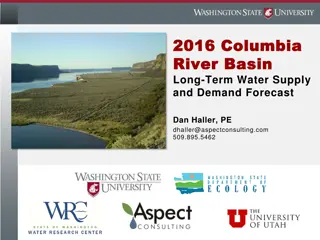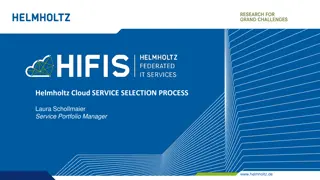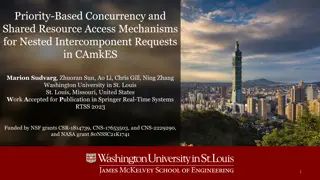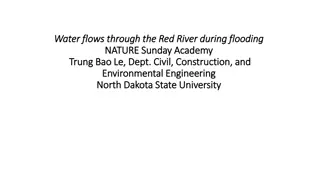Recommendations for Establishing Instream Flow Criteria in Priority Tributaries
This report explores the significance of preserving instream flows in priority tributaries to the Sacramento-San Joaquin Delta and provides recommendations for determining regional instream flow criteria. Key points include the importance of flow regimes in maintaining biological integrity and the development of methodologies that are scientifically sound, cost-effective, and representative at the watershed scale. The panel recommends a hybrid approach that encompasses stream classification, hydrologic analyses, field work assessment, and stakeholder engagement to design effective adaptive management protocols.
- Instream Flow Criteria
- Priority Tributaries
- Sacramento-San Joaquin Delta
- Watershed Scale
- Biological Integrity
Download Presentation

Please find below an Image/Link to download the presentation.
The content on the website is provided AS IS for your information and personal use only. It may not be sold, licensed, or shared on other websites without obtaining consent from the author. Download presentation by click this link. If you encounter any issues during the download, it is possible that the publisher has removed the file from their server.
E N D
Presentation Transcript
Recommendations for Determining Regional Instream Flow Criteria for Priority Tributaries to the Sacramento-San Joaquin Delta A Report to the California State Water Resources Control Board Committee Members Cliff Dahm - University of New Mexico Kirk Winemiller Texas A&M University Marty Kelly Southwest Florida Water Management District (retired) Sarah Yarnell University of California-Davis March 19, 2014
Rivers and Flows Scientific Foundation Global crisis in freshwater biodiversity 0.8% of the Earth s surface is freshwater with 6% of the described species (~100,000) on Earth found in freshwaters with the highest percentage of threatened, endangered, or recently extinct species (~40%) Diminished flows are the primary predictors of biological integrity for fish and aquatic invertebrates in the US relative to eight chemical and physical properties The flow regime is more than just volumes of water; magnitude, frequency, duration, timing, and rate of change of flows all need consideration
Committee Charge Identification of methodology that is scientifically defensible, cost-effective, representative at the watershed scale and timely relative to implementation Input on how recommended methodology or methodologies can be augmented or refined in the future How to develop flow criteria that apply to the majority of the watershed within a tributary that addresses multiple species, different life stages, and different fluvial processes
Panel Recommendation Use of a Hybrid Approach 1. stream and river classification based on geomorphic, hydrologic, geographic, and/or faunal characteristics hydrologic analyses that separate the hydrograph into flow regimes (blocks) and examine historical changes assessment of whether any site-specific field work is required in the catchment or river reach to address specific information gaps extrapolation of understanding of flow-ecology relationships from other sites to the study catchment or segment production of an environmental flow regime that meets the needs of species and ecosystem processes in the system assuring clear and transparent dialogue and interaction between scientists and stakeholders designing an effective adaptive management protocol with robust implementation measurements to support the decision-making process 2. 3. 4. 5. 6. 7.
Setting Flow Criteria for Estuaries and Rivers in the Southwest Florida Water Management District (SWFWMD) The minimum flow for a given watercourse shall be the limit at which further withdrawals would be significantly harmful to the water resources or ecology of the area. Section 373.042 Florida Statutes Environmental flow is the term for the amount of water needed in a watercourse to maintain healthy, natural, ecosystems. Only a few countries, such as Australia, South Africa, and the United Kingdom have integrated the concept into water management.
Period of Record Median Daily Flows for Period of Record Median Daily Flows for Building Block Approach Florida Example Period of Record Median Daily Flows for Alafia River at Lithia, FL Alafia River at Lithia, FL Alafia River at Lithia, FL 600 600 600 B L O C K 2 2 B L O C K B L O C K B L O C K 2 2 B L O C K B L O C K 1 1 500 500 500 Flow (cfs) Flow (cfs) 400 400 400 B L O C K B L O C K 3 3 300 300 300 200 200 200 100 100 100 0 0 0 0 0 0 50 50 100 100 150 150 200 200 250 250 300 300 350 350 Day of Year (Julian Date) Day of Year (Julian Date)
Habitat Suitability Curves Key Non-native Fish Species Key Native Fish Species Key Aquatic Macroinvertebrates Dominant Riparian Plants Riparian Dependent Bird Species
Setting Estuarine Flow Criteria in Texas (River Flow Criteria Already Adopted) basin and bay expert science team shall develop environmental flow analyses and a recommended environmental flow regime for the river and bay system through a collaborative process designed to achieve consensus must consider all reasonably available science, without regard to the need for the water for other uses, and the recommendations must be based solely on the best science available Texas Water Code 11.02362 (m) Senate Bill 3 - 2007
Setting Estuarine Flow Criteria in Texas (continued) Statewide Environmental Flows Science Advisory Committee Bay/Basin Expert Science Teams Address Seasonal and Yearly Fluctuations Support a Sound Ecological Environment Maintain Productivity, Extent, and Persistence of Key Habitats in the Seven Major Estuaries Stakeholder Committee and State Agencies
Setting Flow Requirements Examples from California Restoration of the spring snowmelt recession pattern Restoration of a more natural flow regime on Putah Creek Adaptive management and reconciliation on the North Fork Feather River
Some General Principles For Sustaining Healthy Rivers A modified flow regime should mimic the natural one, so that the natural timing of different kinds of flows is preserved Most water should be harvested from a river during wet months; little should be taken during dry months The seasonal pattern of higher baseflows in wet seasons should be retained Floods should be present during the natural wet season The duration of floods could be shortened It is better to retain certain floods at full magnitude and to eliminate others entirely than to preserve all or most floods at diminished levels The first flood (or one of the first) of the wet season should be fully retained


